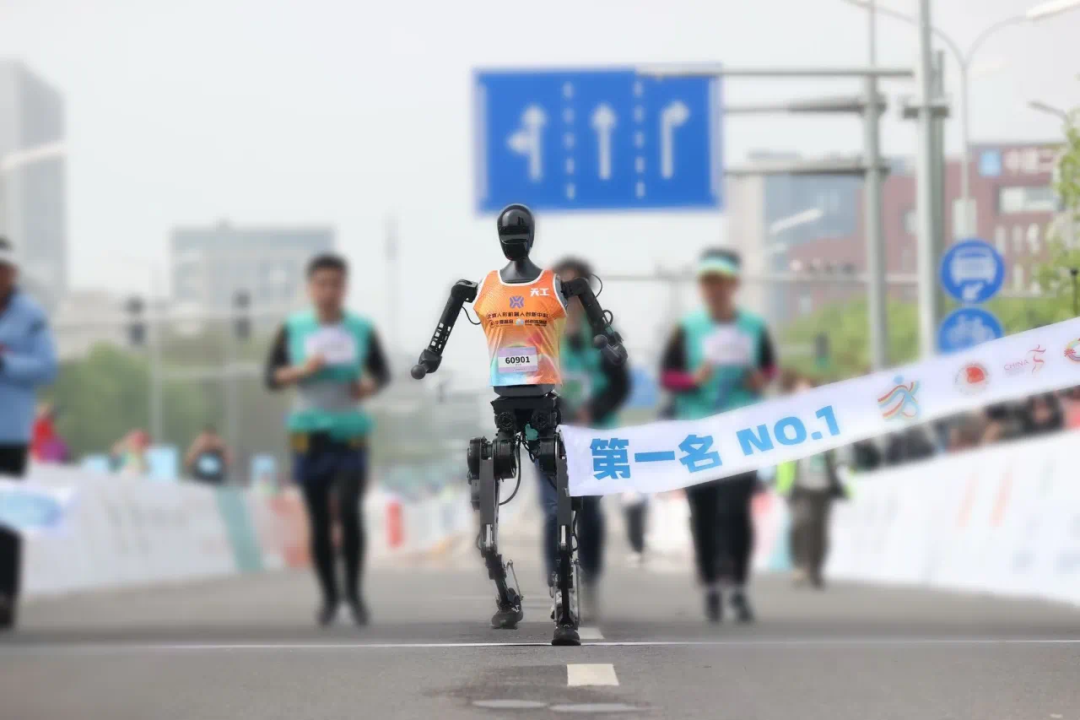April 19
The world’s first humanoid robot half marathon champion has been born!
The humanoid robot team and human runners
simultaneously burst from the starting line
resembling a scene from a sequel to ‘Blade Runner’
This historic moment occurred in Beijing, China
The champion is from UBTECH Robotics, developed in collaboration with the Beijing Humanoid Robot Innovation Center, the ‘Tiangong Ultra’. Shenzhen’s Leju Robotics, with its 55-kilogram ‘heaviest’ competitor, also presented an exciting performance for the audience during the competition…
The transition of robots from the laboratory to the marathon track not only created a visually stunning scene but also showcased breakthroughs in robotic technology, reflecting the explosive growth of Shenzhen’s robotics industry cluster.
 The world’s first humanoid robot half marathon champion has been born! UBTECH helps Tiangong Robotics make history. Image source: UBTECH
The world’s first humanoid robot half marathon champion has been born! UBTECH helps Tiangong Robotics make history. Image source: UBTECH
01‘Robot Valley’ Has Formed
Looking at the map of Shenzhen, it is not difficult to find that along both sides of Liuxian Avenue in Nanshan District, a long “Robot Avenue” of about 10 kilometers is quietly taking shape, whereemergescompanies like Zhongqing, Pudu, UBTECH, Puxini, Zhi Ping Fang, Zhujidongli, Digital Huaxia, and Kuawei Intelligentare known as the ‘Eight Great Kings’ in the robotics field, along with the so-called ‘first stock of humanoid robots’ UBTECH, ‘first stock of LiDAR’ SUTENG JUCHUANG, and ‘first stock of collaborative robots’ YUEJIANG Technology, a large number of technology innovation enterprises are sprouting up like bamboo shoots after the rain.
This innovation corridor connecting the Xili Lake International Science and Education City, Liuxian Cave headquarters base, and Nanshan Smart Park is not only an important node in the Guangdong-Hong Kong-Macao Greater Bay Area’s technology innovation corridor but also reconstructs the global landscape of the robotics industry with a ‘university-research institute-enterprise’ golden triangle structure, forming a globally renowned ‘Robot Valley.’
Starting from the University Town subway station, within a radius of 0.5 kilometers, the bionic laboratory of the Southern University of Science and Technology’s robotics research institute is testing a multi-dimensional tactile sensor that can perceive a pressure of 0.1 grams; within a radius of 1.2 kilometers, engineers from Harbin Institute of Technology (Shenzhen) are debugging the fourth-generation solid-state LiDAR in the LiDAR laboratory; within a radius of 3 kilometers, UBTECH’s ‘Future Factory’ is assembling the new generation Walker S humanoid robot, while the neighboring Zhi Ping Fang’s Alpha Bot has already begun learning automotive wiring harness assembly.
In Nanshan, Shenzhen, a ’15-minute innovation circle’ has already formed.Nanshan District has implemented a grid layout for universities, research institutions, and corporate headquarters.
As the president of Shenzhen University of Technology, Fan Jianping, stated: ‘Here, professors can validate their research results on the production line of a neighboring enterprise by the afternoon.’ This is particularly evident at the Liuxian Cave headquarters base: Puxini’s tactile sensors are directly supplied to UBTECH just across the street, while Kuawei Intelligent’s simulation data is input in real-time into Zhi Ping Fang’s training system, forming a collaborative rhythm of ‘morning research, afternoon testing, evening iteration.’
02The Dance of Policy and Capital
This efficiency in technology transformation is further accelerated with policy support.
The ‘Embodied Intelligent Robot Industry Development Action Plan’ released by Shenzhen in 2025 proposes that by 2027, more than 10 enterprises with a valuation exceeding 10 billion yuan and more than 20 enterprises with revenue exceeding 1 billion yuan will be cultivated, achieving the landing of over 50 application scenarios at the 100 million level, with the related industry scale exceeding 100 billion yuan, and more than 1,200 enterprises related to the embodied intelligent robot industry cluster.
Recently, the Nanshan District Committee and District Government released the ‘Nanshan District Support for Innovation and Entrepreneurship Six Ones Action Plan,’which aims to solve the survival dilemma of startups by ‘zeroing costs,’ forming a closed-loop ecosystem of ‘government platform, mentor empowerment, market validation,’ compressing entrepreneurial costs to nearly zero, covering the full-cycle needs of talent introduction, space supply, and financial support.
This further stimulates the innovation and entrepreneurial vitality of the entire society, builds a technology innovation ecosystem and talent development environment, and helps develop new quality productive forces, fully constructing a world-class modern innovation urban area.
The capital market’s sensitivity is even sharper.
Liu Suhua, president of Shenzhen Capital Group, stated publicly that by the end of 2024, Shenzhen Capital Group has invested in 48 projects in the robotics industry chain, with a total investment of 1.43 billion yuan, covering the complete industrial chain of robotic components, of which 410 million yuan has been invested in Shenzhen, accounting for nearly 30%.
03Using ‘Valley’ as a Vessel to Navigate into the Deep Waters of the Intelligent Era
Recently, the ‘Eight Great Kings’ of Nanshan’s robotics industry danced with street dancers at the Shenzhen Bay Sports Center, where the Zhongqing humanoid robot completed the world’s first front flip stunt, and UBTECH conducted the world’s first collaborative training of humanoid robots across multiple machines, scenarios, and tasks at the Geely 5G smart factory…
Currently, the added value of the robotics industry in Nanshan District accounts for about 30% of Shenzhen’s total, making it the largest robotics district in Shenzhen, already gathering more than 30 high-quality upstream and downstream enterprises and institutions in the industry chain.
The development of robotics in Shenzhen is currently forming a ‘tropical rainforest-style’ innovation ecosystem: the government reduces the risks for startups through angel funds and computing power subsidies; universities cultivate interdisciplinary talents through ‘new engineering’ education; and upstream and downstream enterprises in the industry chain form a ‘symbiotic alliance’ to share technology and bear costs together.
The capital’s sensitivity has confirmed the potential of this land.From a manufacturing base of ‘processing trade’ to a global source of robotics innovation, Shenzhen’s transformation is a microcosm of China’s industrial upgrade.
As robots move from science fiction to reality, Shenzhen is using ‘valley’ as a vessel to navigate into the deep waters of the intelligent era.
This is a mutual journey of a city and an era.
In the future, Liuxian Avenue may become China’s ‘Robot Avenue,’ and the story of Shenzhen’s ‘Robot Valley’ may become a classic narrative of technological innovation and urban evolution, much like Silicon Valley.
News
Everyone is Watching
Beautiful! Looking forward to the new undergraduate major +29! This year’s college entrance examination can register for 33525.51 billion! In the first quarter, Guangdong’s GDP grew by 4.1% year-on-year.
Source | Yangcheng Evening News · Yangcheng Pai
Editor | Zhang Yuan
Proofreader | Lan Shuru
